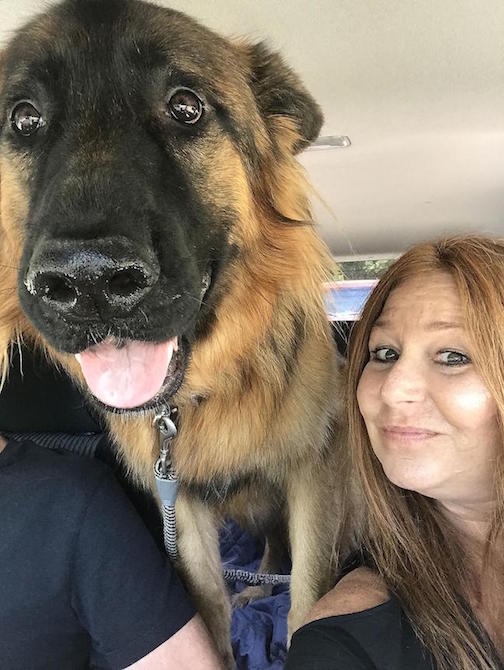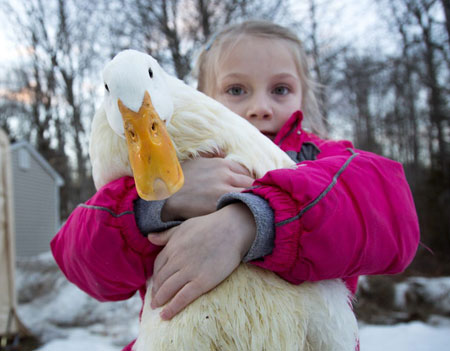Dave Barry Talks About His Dog - Lessons From Lucy
 The extremely talented and very funny author Dave Barry is our guest. He'll tell us about the lessons he has learned from his dog Lucy. He says Lucy taught him to effectively deal with road rage. Dave also explains why he's not much of a cat fan.
The extremely talented and very funny author Dave Barry is our guest. He'll tell us about the lessons he has learned from his dog Lucy. He says Lucy taught him to effectively deal with road rage. Dave also explains why he's not much of a cat fan.
Normally when Dave is in his office working (according to him if you can call it work!) his dog Lucy is right by his side. However, when he told her she had a chance to be on Animal Radio, she chose to take a walk instead! Nevertheless, Dave has a new book out called, "Lessons From Lucy: The Simple Joys of an Old, Happy Dog." In fact, both he and Lucy are on the front cover. However, in the picture Dave doesn't look like the 70-year-old he professes to be. But because he and Lucy are both old now, he says that was the impetus for the book.
Dave claims that he might look younger than his years because he has gone several decades without doing any productive work, which he claims is good for a person and he recommends it to everyone, especially the federal government.
Lucy is Dave's only pet, unless you count his fish. He says he has a number of fish, but he doesn't really know how many, because his wife spends her life trying to keep them alive. Lucy is his main pet and he's always tried to have a dog because dogs are wonderful pets, as everybody knows. So what does Dave think of cats? Dave says he's a little reluctant to comment on our show, which probably has a lot of cat fans. Unlike cats, Dave sometimes takes Lucy to a dog park. At the park, the dogs are all running around playing with each other and their owners are naturally kind of gathered together. Most people probably don't even know the owners of the other dogs. However, if your dog is playing somebody else's dog, you end up talking with that person and it's a very social and happy occasion. Now, try to imagine a cat park. Dave pictures it as a field of people standing about 20 to 30 feet apart from everybody else looking off in the distance saying, "Where in the hell is my cat?"
Dave does tell us that he has had cats in his life. He doesn't say he hated them, but he never felt they liked him all that much. He does have one cat experience though. His sister loved all animals and she had a cat. One time she asked Dave to drive the cat for her from one location in New York to another. He was about 17 or 18 years old at the time. He felt he had the cat safely secured in a crate in the backseat of the car. He was then zipping down the Taconic Parkway at 70 miles an hour when he suddenly realized the cat was directly under the accelerator pedal. There's no real good way to handle that. If you reached down and tried to grab the cat, the cat is not going to react well to that at all. Plus, you won't be able to see. He was trying to hit the brake, but he didn't want to step on the cat, which would be a mistake. So, he says that he never really had a chance to develop a good, meaningful, long-term relationship with a cat.
No surprise, as there are both dog and cat people in the world. To be both, Dave feels you would have to have dogs and cats that got along pretty well; otherwise it would be a nightmare.
"Lessons From Lucy," Dave's latest book, has seven lessons in it. Normally, when you think about Dave, you don't think of him a self-help author. Dave explains that his new book is decidedly a departure. He states that when people usually read his books, they don't feel helped and they often come away from his book saying, "That didn't help me at all. I actually feel stupider now having read that book, thanks a lot!" However, Dave doesn't mean this latest book to be a self help book in the kind of classic, "Here's some stuff you don't know that I know that will make you a happier, better [person]." In fact, he tells us that it doesn't contain anything that you don't already know. There is not a single thing in the book that pretty much every sane adult wouldn't know.
 But, the book is about basically things that his dog Lucy does, which most dogs do, that makes her happy even though she's getting old like he's getting old. Somehow Lucy stays happy and joyful and positive and kind of always in the moment just by doing things that even Dave could do. He could do all of those things and yet, like many people, especially people as they get on in years, have stopped doing a lot of things that makes them happy. This really is the premise of the book and him trying to be funny along the way, but that is what he was trying to get to, are things that Lucy his dog does that make her happy and that he can do to make himself happy, except for drinking from the toilet!
But, the book is about basically things that his dog Lucy does, which most dogs do, that makes her happy even though she's getting old like he's getting old. Somehow Lucy stays happy and joyful and positive and kind of always in the moment just by doing things that even Dave could do. He could do all of those things and yet, like many people, especially people as they get on in years, have stopped doing a lot of things that makes them happy. This really is the premise of the book and him trying to be funny along the way, but that is what he was trying to get to, are things that Lucy his dog does that make her happy and that he can do to make himself happy, except for drinking from the toilet!
Most of the lessons in the book are obvious, but sometimes we need someone to bring them to our attention and to put them into perspective. One such lesson is about letting go of your anger, especially road rage. Dave lives in Miami, where he said he moved in 1986 from the United States. He claims it is a different world to drive there. When he first got there, he thought no one in Miami understood the traffic laws. He has since figured out that everybody in Miami is driving according to the traffic laws of his or her individual country of origin. So you have many, many different interpretations with regard to stop signs, using a blinker and even yellow lights.
So the lesson from Lucy is that if someone cuts Dave off in traffic, it might be annoying, but he doesn't really need to think about it the rest of the day. He doesn't need to wake up in the middle of the night still thinking about it, but he does. That is what is so wonderful about dogs, they can get mad and then let it go. For example, the thing that really infuriates Lucy is when, and this happens every week if you can believe it, a man comes and takes their garbage. The garbage cans are right outside the office window and Lucy goes up to the window and barks like crazy. She then looks back at Dave like, "Are you going to just let them take our garbage! You're just going to sit there and do nothing?" But then literally the second they go around the corner with the garbage, Lucy is back on the floor relaxing. She's done her job. She's not going to think about that again until it happens again. It's over for her. Dave is so envious of Lucy's ability that she has to just let go of anger. Holding on to anger doesn't do you any good. Almost all of the stuff you get angry about it, at least what Dave gets angry about, is trivial and unimportant in the long run. It's just we have trouble seeing the long run, unlike Lucy who just lets it go.
This is just one of the many lessons in the book that Dave tries to emulate Lucy in. If we could all become more ‘dog like,' we'd probably all get along much better.
Visit Website
Unique Ways To Memorialize Your Pet
Steve Munt, Pikachu Into Space
 Steve Munt wants to send the cremains of his beloved cat into space. While dog lovers have been memorializing their dogs this way for years, Steve's cat will be the first feline remains shot into space in a satellite that will circle the earth in perpetuity. Steve is our guest and he'll explain why he wants to do this.
Steve Munt wants to send the cremains of his beloved cat into space. While dog lovers have been memorializing their dogs this way for years, Steve's cat will be the first feline remains shot into space in a satellite that will circle the earth in perpetuity. Steve is our guest and he'll explain why he wants to do this.
Steve Munt owns seven cats. While they are all special, Pikachu was especially special who unfortunately expired. Steve has the cremains of Pikachu and wants to send them into space.
When this story first broke, it was reported that Steve worked at NASA, which we understand is actually not the case. Steve explains that he actually worked on software for the Hubble Space Telescope. He was a contractor and worked on NASA projects in 1980. He tells us the story kind of went crazy as it went national and international. So there were errors that got introduced to the story.
But essentially, Steve wants to send the cremains of Pikachu up into space, which would actually be the first cat in space. To raise money for this launch, Steve started a GoFundMe page, which had been directed originally towards his Twitter followers. He is still raising money, but he did want to secure the flight, so he actually has already signed the contract and made a payment on his credit card.
Currently, Steve is currently waiting for assignment to a flight and details on a flight date. He anticipates it will happen within the next 18 months.
Steve explains that there are many reasons he wants to do this. He tells us that Pikachu was very special to his family, both to the humans and to the other cats. He actually helped another cat of Steve's, named Zee, who had some pretty serious illnesses and has had a lot of medical treatment. This treatment has included a blood transfusion, stem cell therapy and acupuncture for chronic kidney disease. Pikachu showed up at a time where Zee just needed some reenergizing and he was able to do that for Zee in an amazing way.
 Zee has a Twitter account with over 12,000 followers and Pikachu has been featured on that account. Zee's followers have really fallen in love with Pikachu. They followed the story as Pikachu he himself became ill and had a hospitalization, where he ultimately died, while Zee lives on.
Zee has a Twitter account with over 12,000 followers and Pikachu has been featured on that account. Zee's followers have really fallen in love with Pikachu. They followed the story as Pikachu he himself became ill and had a hospitalization, where he ultimately died, while Zee lives on.
Literally thousands of people on Twitter were morning Pikachu's passing along with Steve. When he was looking for a way to memorialize Pikachu in a special way, he was looking for something that he could do for his family, but something that could include the Twitter followers as well, and a space launch just seemed to fit the bill.
On Zee's Twitter account, he has been personified and Steve explains that there's a very scientifically kind of feel to the Twitter feed. And once Pikachu goes up, the satellite can be tracked at all times. His Twitter followers can basically know when Pikachu is flying overhead.
Visit Website
What's Your Vet-iquette - How to Be a Good Veterinary Client - Dr. Debbie
 Sure you think your vet visits go off without a hitch, but do you know how to be a good veterinary client, the kind veterinarians rave about? Follow these suggestions to participate as a vital part of your pet's medical care, to ensure your pet gets the most efficient care, and to always be greeted with beaming smiles.
Sure you think your vet visits go off without a hitch, but do you know how to be a good veterinary client, the kind veterinarians rave about? Follow these suggestions to participate as a vital part of your pet's medical care, to ensure your pet gets the most efficient care, and to always be greeted with beaming smiles.
Be Prepared
Before you arrive at the office with a sick pet, know your pet's ins and outs. Without a pertinent history from you, your veterinarian may need more diagnostic tests to sleuth out the answer to the problem. That takes time and can cost you more in veterinary bills.
Expect the questions your vet is likely to ask you. Has your pet been eating? What types and brand of food do you feed him? Is there diarrhea or constipation?
Bring Evidence
Nothing is more useful to your veterinarian as seeing something with her own eyes. Bring evidence like stool samples, vomited material, and medications your pet is receiving. Has your pet chewed on some unusual plant in the backyard? By all means bring a sprig of that plant.
Document video on your smart phone. This can be immensely helpful to your veterinarian to witness behaviors that may be intermittent. I've been thankful when owners bring smart phone video of seizures, separation anxiety behaviors, and respiratory ailments.
Video eliminates misinterpretation by pet owners, and can permit a quick veterinary diagnosis. Vomiting and regurgitating may look similar, but are caused by different disorders. Pets strain to defecate with both diarrhea and constipation. Inspiratory wheezing, coughing, congestion and reverse sneezing are often described similarly by owners.
Trust Valid Resources
By all means do your research in advance of your veterinary visit. Know what questions to ask. But remember that the internet is abounding with both good and blazingly incorrect information, some based on opinions and conjecture without any sound medical basis. Pet owners who value Dr. Google's opinion over their veterinarian, who has examined their pet, could put their pet's health care in jeopardy.
Confine Your Pet
Make sure your pet is secure before entering the veterinary hospital. Don't underestimate the unpredictable things pets do in a noisy, crowded waiting room. Birds fly off shoulders landing in snack zone of nearby dogs. Dogs instigate fights, and cats flee the waiting veterinary staff's arms. Pay attention to where your pet is and don't allow your pet to approach other animals without the owner's consent. Some animals are there because they are sick, and could bite in unfamiliar surroundings.
Dogs should be on a secure leash. Flexi leashes are dangerous in the veterinary hospital allowing dogs to bolt quickly toward another dog, or to entangle limbs of humans or other animals in the waiting room. Cats and exotic pets should be secured in an appropriate pet carrier.
If you have a pet that has been or could be aggressive to veterinary staff…absolutely share that information before the visit starts. Veterinarians look out for the safety of people in their employment and appreciate a heads-up in advance to avoid potential staff injury.
 Optimize Your Face Time
Optimize Your Face Time
So now you are in the exam room with the doc, so make the most of it. Put the cell phone away and, by all means, don't waste time taking a phone call if medical staff is standing in front of you.
Avoid distractions that will limit your ability to communicate with your veterinarian. This might include a roomful of boisterous children or other pets. If possible, arrange child care or pet sitting so your sick pet gets prime attention and you don't miss any details of the visit.
Emergencies Happen
At the vet office, we recognize how valuable pet owner's time is and try to minimize the wait. But recognize that emergencies are unforeseen and create delays for other pet owners. Most folks understand that emergencies happen and are accommodating during situations as this.
But making a scene or outburst about your wait time, while the veterinary staff tends to a critical pet is just inconsiderate. Recognize that one day your pet could be in that same place and you would be appreciative that your pet's medical emergency was triaged ahead of the waiting routine appointments.
Don't Attack the Messenger
Emotions can run high when you have a sick or injured pet, but it isn't an excuse to be abusive to hospital staff. Obscene language and overly aggressive behavior doesn't help your pet get the care she needs, nor does it endear yourself to those people working hard for your pet's health.
Own Your Own Reality
Pet owners have the daunting responsibility for the health and well-being of pets in their care. That means accepting the level of veterinary care you can pursue, and recognizing choices if finances are limited. Pet insurance can help defer the cost of veterinary care, but there isn't government sponsored Obamacare for pets.
Don't blame your veterinarian for your pet's health maladies, or expect her to cover the costs of treatment. People in the veterinary field do what they do because they love animals, but they shouldn't be expected to take financial responsibility for everyone's pets. I once heard a veterinary colleague respond to an client's question, "Doc, why can't you just do my Sasha's surgery for free?" His response was, "Because my staff needs to get paid and my kids need shoes." Recognize that veterinary offices aren't lending institutions, but rather are small businesses with pressing bills, just as anyone.
Share Your Feedback
Share feedback with the hospital management about service excellence or shortcomings. Every hospital appreciates the opportunity to improve, or the chance to pat staff on the back.
Featured veterinarian known as "Dr. Debbie" on national pet radio program, Animal Radio. Ebook author of "Yorkshire Terriers: How to Be Your Dog's Best Friend"; "Pugs: How to Be Your Dog's Best Friend"; "Mini Schnauzers: How to Be Your Dog's Best Friend"; and "Shih Tzu: How to Be Your Dog's Best Friend." Dr. Debbie's books.
Visit Website
 The Dogfather's Grooming Tip with Joey Villani
The Dogfather's Grooming Tip with Joey Villani
Trimming Your Pet's Nails
Joey tells us that he doesn't understand why anyone would want to trim their pet's nails at home by themselves. Fortunately a lot of people don't do this, so they don't know what they could encounter.
When cutting your pet's nails, if you happen to cut them too short, it is not actually the cutting of the nails too short, it's the screaming and the biting that goes along with it, unless you have really well behaved animals.
However, if you want to cut your pet's nails at home, Joey explains that you need the right equipment, which is really important. You need to have professional style nail clippers, which are not all that expensive. They can range anywhere from $5 to maybe $15 at the most. In fact, Joey says he recently saw a pair of cat nail clippers in the dollar store and they were actually decent stainless steel ones.
The thing you want to do is make sure you get the right size. Some people think you can use any size clipper for all animals. But, if you have a small dog, you want to use small nail clippers. If you have a cat, use cat nail clippers. If you have a large breed, use large breed nail clippers. Using the right tool is going to make it a lot easier for you.
Secondly, and this is important, you need styptic powder. If you cut your pet's nails too short and into the quick, it's going to bleed. So you really need to have something on hand just in case. However, it's important that you try not to hit the quick, because you're just going to traumatize your pet forever, especially if you have a cat. If you've ever cut into the quick on a cat, you'll never be able cut their nails again.
 In a pinch, you can use cornstarch if you don't have any styptic powder. It will work, but it doesn't work as well. Just remember, your pet is not going to bleed to death. They're going to bleed and it's going to be messy. However, it's a clean cut, just like when you shave and you cut yourself with a razor blade, it's going to bleed for a while. While the cornstarch will coagulate the blood flow, it may take a little while. Another thing you can use in a pinch is a bar of soap, but it's going to burn a little bit. Just run a bar of soap on the cut nail to seal the area.
In a pinch, you can use cornstarch if you don't have any styptic powder. It will work, but it doesn't work as well. Just remember, your pet is not going to bleed to death. They're going to bleed and it's going to be messy. However, it's a clean cut, just like when you shave and you cut yourself with a razor blade, it's going to bleed for a while. While the cornstarch will coagulate the blood flow, it may take a little while. Another thing you can use in a pinch is a bar of soap, but it's going to burn a little bit. Just run a bar of soap on the cut nail to seal the area.
If your pet has a clear nail, you can actually see the quick. If you'll look, you'll see a pink inlay. It sort of looks like a funnel thing in there and you want to get as close to that as possible without hitting it. Why would you want to get so close to it? If you get real close, the quick is going to retract back into the bed of the nail. This will allow you to cut it shorter next time. And over time, you can get it down to where it needs to be.
Black nails are a little bit harder. You need to start out by taking just a little bit of the nail and then look at the cut. The nail, once you cut it, is going to have a white center. Keep cutting a little bit off at a time, and when you see a little piece of black peeking through the center, that means you're right up to quick and you can back off.
There is a nail clipper available, for around $15-$20, that actually has a quick finder in it. It has three lights, red, yellow and green. What you want to do is to get the yellow light to turn on and then cut the nail. That means you're as close as possible. These clippers work really well according to Joey.
However, if you're not comfortable and are not sure what you are doing, don't ruin your pet's experience. Your uncertainty is going to make your pet uncertain and they're going to dread this every time it needs to be done. In this case, just go to your professional, they're not that expensive. Most groomers and veterinarians charge between $10-$20 to trim a pet's nails.
Remember, having your pet's nails trimmed on a regular basis is necessary to keep their feet in good health.
Animal Radio News - Lori Brooks
 Imported Asian Canine Distemper A Threat To Other Species
Imported Asian Canine Distemper A Threat To Other Species
A young dog imported from South Korea into Western Canada brought along a dangerous hitchhiker, the Asia-1 strain of canine distemper virus (CDV), which until then had not been reported in North America. Scientists at Cornell University College of Veterinary identified the virus in samples from the dog, which they suspect was part of a shipment of animals rescued from a Korean meat market. Dogs that are already immunized against CDV are likely not at risk from the Asian strain. However, viral disease experts warn, "If this particular Asia-1 strain got out into the wildlife population, then it's here forever, because you can't get rid of it once it hits wildlife." About two weeks after the sick dog's arrival in Canada, it developed a cough and was lethargic. Ten days later it developed muscle twitches then seizures and was ultimately euthanized. The AHDC tested samples collected from the animal, which were negative for canine influenza virus but gave strong positive results for this strain of distemper. Canine distemper virus is highly contagious and commonly travels between hosts through the aerosols emitted when dogs bark and cough as well as through urine and feces. The disease starts with respiratory symptoms, such as coughing and pneumonia, and progresses into gastrointestinal illness and neurological problems. Most dogs in the United States receive vaccines for CDV to protect against native North American strains of distemper. Keeping new infectious organisms out of the U.S. is challenging because there is virtually no federal oversight of imported companion animals.
 Woman Awarded $60,000 After Dog Dies In Trainer's Care
Woman Awarded $60,000 After Dog Dies In Trainer's Care
A woman in Napa, California, whose German Shepherd died while in the care of a dog trainer has been awarded $60,000 by a County Court. She sued the trainer for negligence, breach of contract and violation of state health and safety codes. A necropsy revealed her dog had died from heat stress or hyperthermia after less than three weeks in the trainers care. Police officers also found inhumane and cruel conditions at the home where the dog, Gunnar, had likely been held.
Cities With The Most Dog Parks
The Trust for Public Land has released its latest assessment of the nation's dog parks. It reports that there are currently 810 off-leash dog parks in the nation's 100 largest cities. Since 2009, the number of dog parks in those bigger cities has increased by 42-percent. The city with the most dog parks is New York, with 145. However, the list or rankings is based in the number of off-leash dog areas per 100,000 people. Based on that qualifier, the top cities for dog parks are: Boise, Idaho, with 13 total dog parks, or 5.7 per 100,000 residents; Portland, Oregon, with 35 total dog parks, or 5.4 per 100,000 residents; and Henderson, Nevada, with 15 total dog parks, or 5.0 per 100,000 residents. Other cities in the top 10 include Norfolk, Virginia (4th place); San Francisco, and Tampa, Florida (tied for 5th place); Las Vegas; Nevada, and Madison, Wisconsin (tied for 7th place); Oakland, California (9th place); and Arlington, Virginia (10th place).
Pet Duck? Why Not! 
A lot of kids go to the park to see ducks, but 8-year-old Kylie Brown of Freeport, Maine takes her duck to see the park. If you missed the viral story about Kylie and her duck, his name is Snowflake. She takes it to the pond at a park and it even returns when she calls his name. Kylie's parents say Snowflake has had to be by their daughter's side 24/7 since the day they brought him home. So they brought him in the house, put a diaper on him and now he's a house duck.
 Listen to the entire Podcast of this show (#1010)
Listen to the entire Podcast of this show (#1010)





